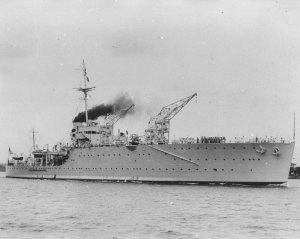HMAS Albatross (I) commissioned at Sydney on 23 January 1929 under the command of Captain Denham Bedford, RN, and began her seagoing career a week later, cruising south to Tasmania and Victoria as a unit of the RAN Squadron. The next four years followed the normal uneventful pattern of the peacetime naval vessel of the thirties on the Australia Station - winter cruises to New Guinea and New Britain and surrounding islands, spring cruises to the southern states, exercises, training and long periods in Sydney Harbour.
In August 1930 Captain Henry Feakes, RAN assumed command from Bedford and was in turn relieved in August 1931 by Captain Cuthbert Pope, RAN. In March 1933 Captain Harry Howden, RAN assumed temporary command from Captain Pope, but he remained in command until the ship paid off.
On 26 April 1933 Albatross (I) paid off into E-Class Reserve and for the next five years remained at anchor in Sydney Harbour. In 1938 she was accepted by the Admiralty in part payment for the RAN"s new cruiser Hobart (I) and was recommissioned on 19 April 1938 under the command of Captain Hubert Acland, DSO, RN. On 11 July 1938 she sailed for England carrying as her crew over 300 RAN personnel who were to commission Hobart. She sailed via Darwin, Singapore, Colombo, Aden, the Suez Canal and Gibraltar before arriving at Plymouth on 9 September 1938 where she was handed over to the Royal Navy and placed in reserve; her life as an RAN warship at an end.
Shortly before World War II began HMS Albatross recommissioned from reserve and embarked six Walrus I amphibians. As a seaplane carrier she served in the South Atlantic, West Africa and Madagascar areas. She paid off in 1943, but again recommissioned the following year, this time as a fleet repair ship.
In 1944 while operating as a fleet repair ship she took part in the Allied invasion of Normandy, restoring 132 vessels to fighting service in the assault area. On 11 August she suffered considerable damage when struck forward by a torpedo off Courseulles. Casualties exceeded 100, including 50 killed.
In 1946 the Admiralty sold Albatross to a British company which planned to convert her into a passenger luxury cruiser. High conversion costs caused abandonment of the scheme and it was decided to use the ship as an off-shore floating cabaret at Torquay on the Devonshire coast. However, she was saved from this fate when the Greek-British Yannoulatos Group of shipowners offered to buy her for the sum of £185,000. The deal was completed on the day Prince Charles was born (14 November 1948) and in his honour her new owners renamed the ship Hellenic Prince.
The Yannoulatos Group sent her to Barry in Wales, where she was converted to a modern passenger vessel at a cost of £200,000.
In late 1949 she was chartered by the International Refugee Organization as a refugee transport. On 5 December 1949 she reached Sydney carrying 1,000 displaced persons thus returning to her birthplace after an absence of more than eleven years.
The ship"s career finally ended when she was scrapped at Hong Kong on 12 August 1954.
Specifications
 |
| Class |
N/A |
|---|---|
| Type |
Seaplane Tender |
| Motto |
Usque Ad Nubes Prolem Emitto |
| Builder |
Cockatoo Docks and Engineering Company Pty Ltd, Sydney |
| Laid Down |
16 April 1926 |
| Launched |
23 February 1928 |
| Launched by |
Lady Stonehaven, wife of the Governor-General |
| Commissioned |
23 January 1929 |
| Decommissioned |
26 April 1933 |
| Fate |
Transferred to Royal Navy in 1938 |
| Dimensions & Displacement | |
| Displacement | 4,354.49 tonnes |
| Length | 135.02 metres |
| Beam | 18.29 metres |
| Draught | 4.95 metres |
| Flight Deck | None |
| Performance | |
| Speed | 20 knots |
| Range |
|
| Complement | |
| Crew | 450 (including six officers and 24 airman from RAAF) |
| Propulsion | |
| Machinery | 4 x Yarrow boilers, Parsons Turbines, 12,000 shp, 2 shafts |
| Horsepower | 12,000 |
| Armament | |
| Guns |
|
| Other Aircraft | 9 floatplanes or amphibians such as Supermarine Seagull and Walrus (6 active, 3 reserve) |




